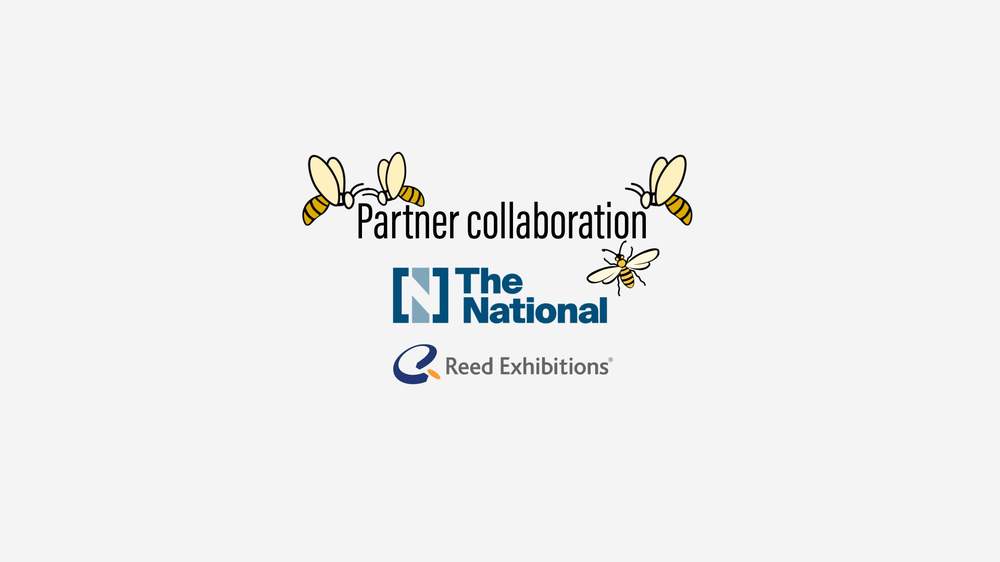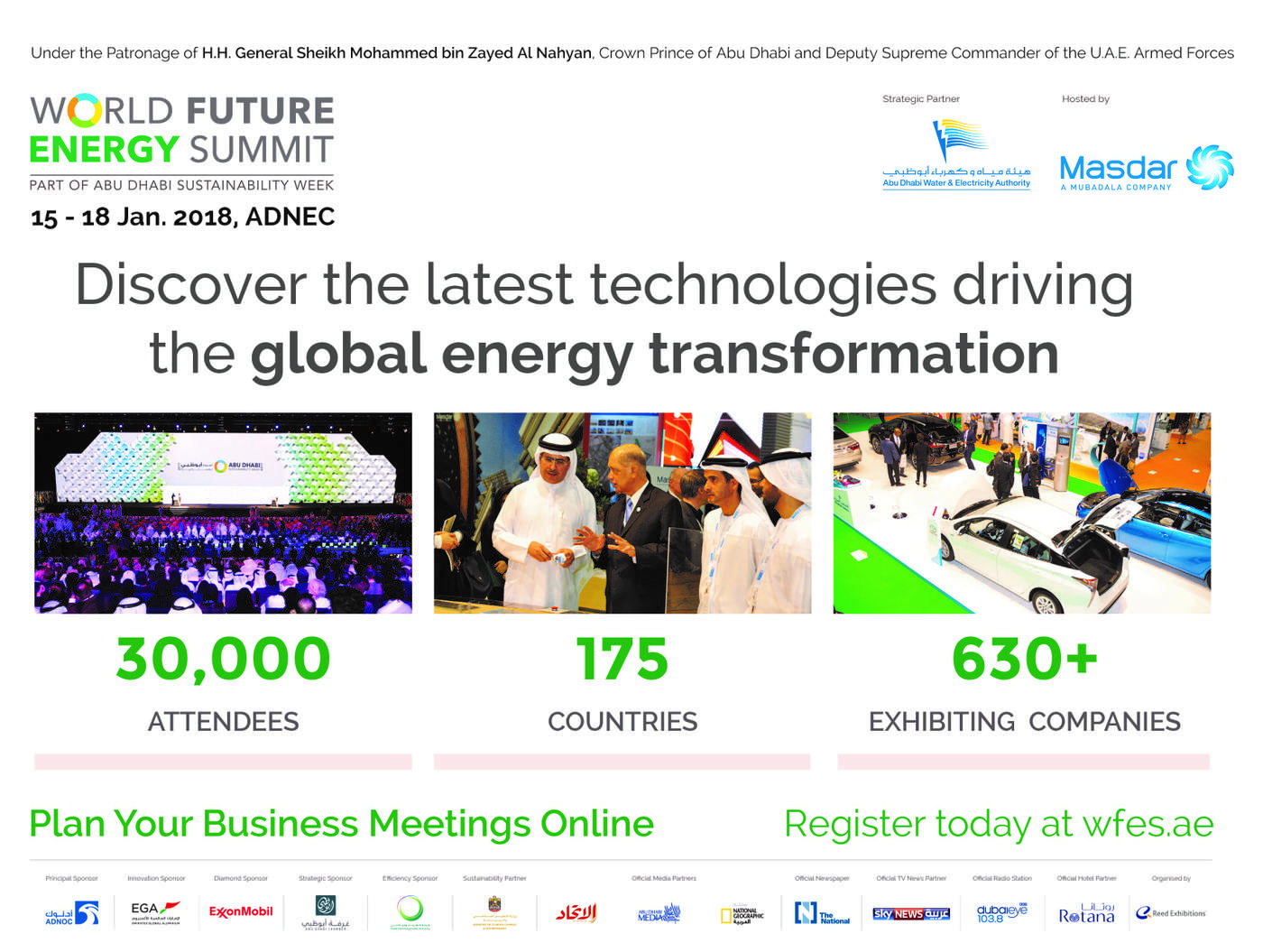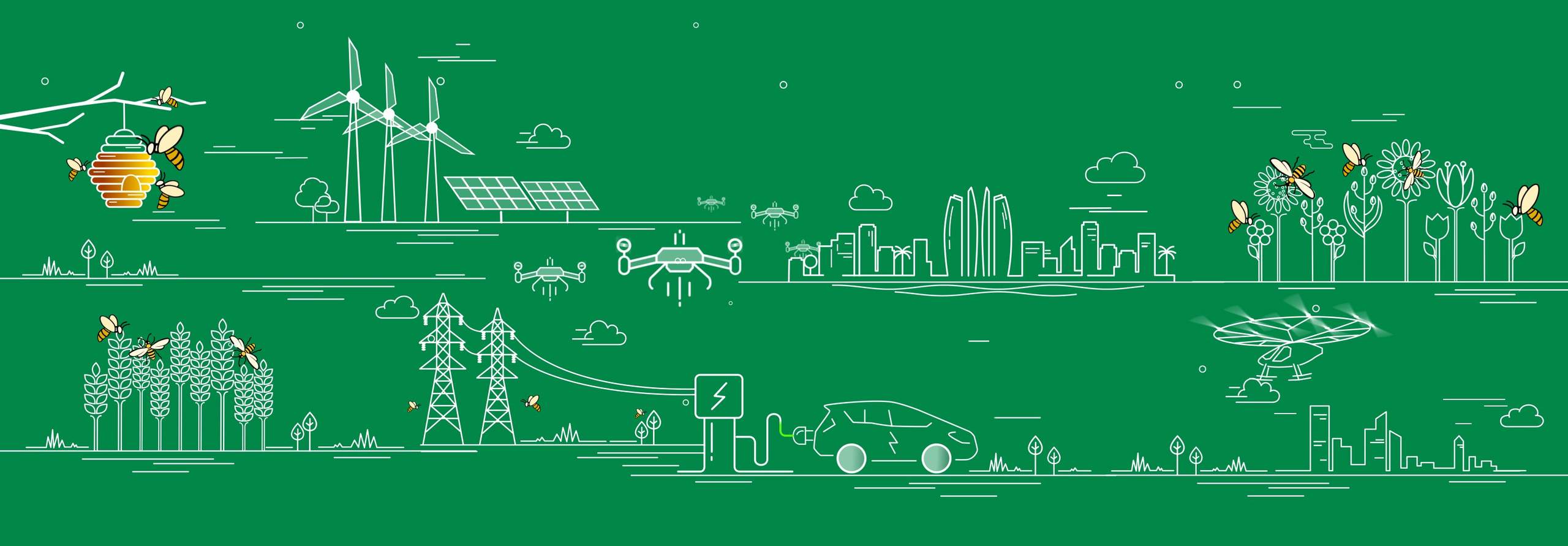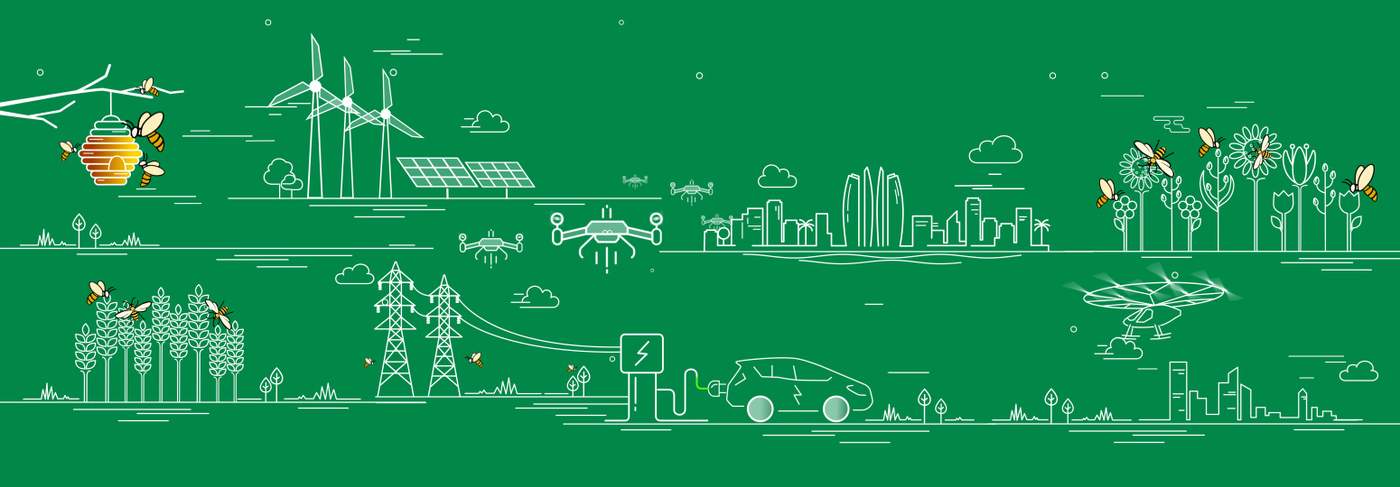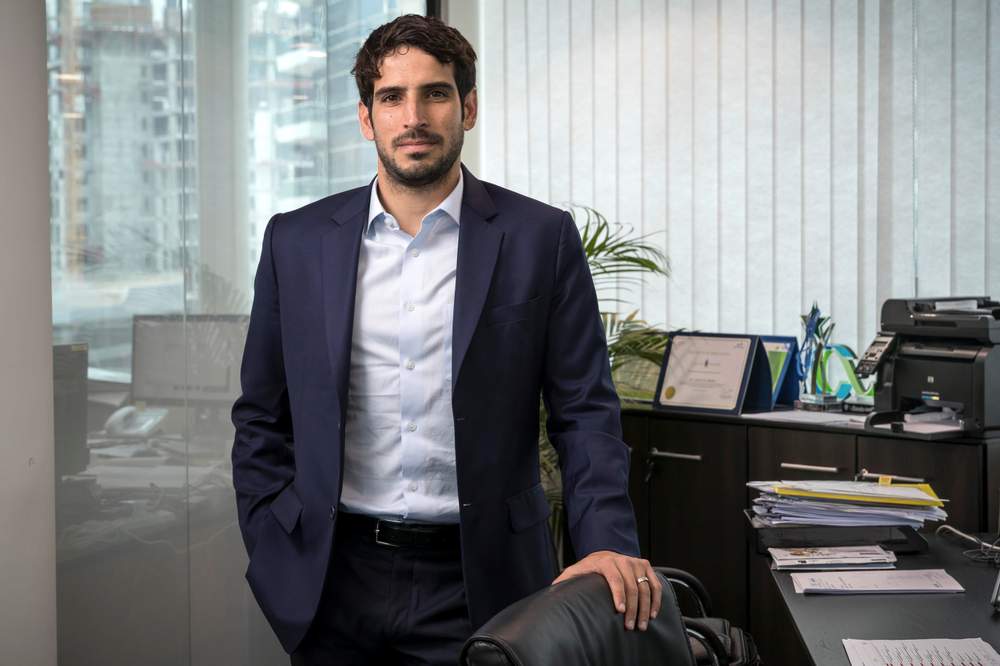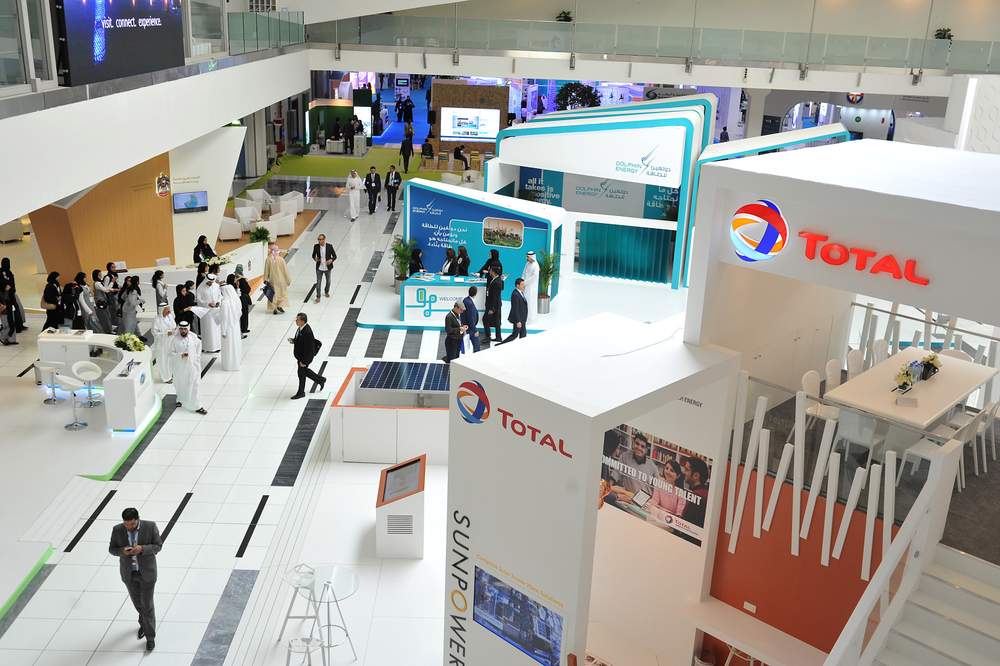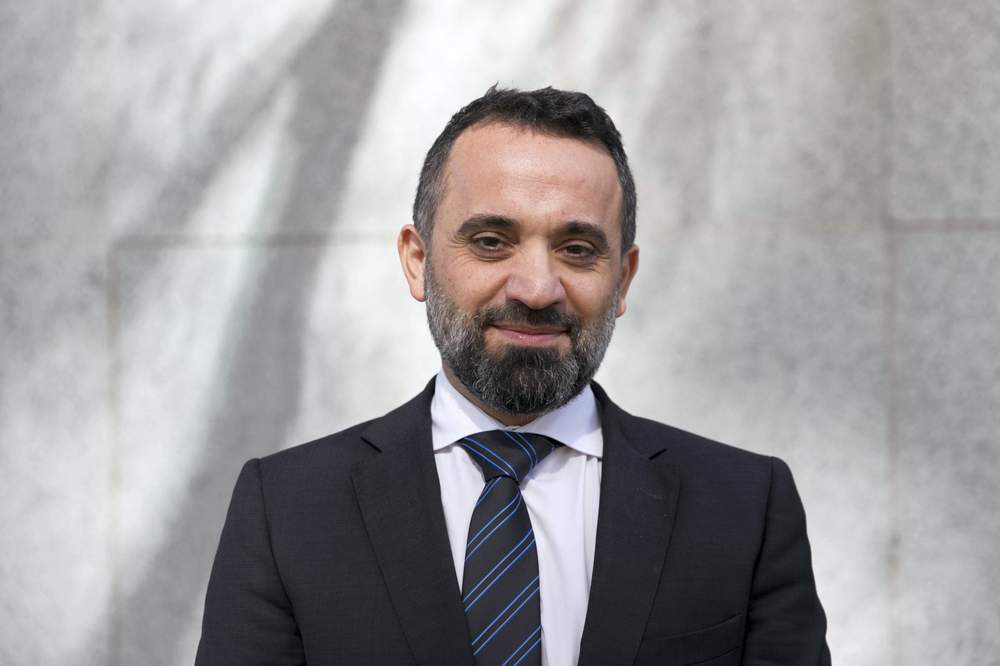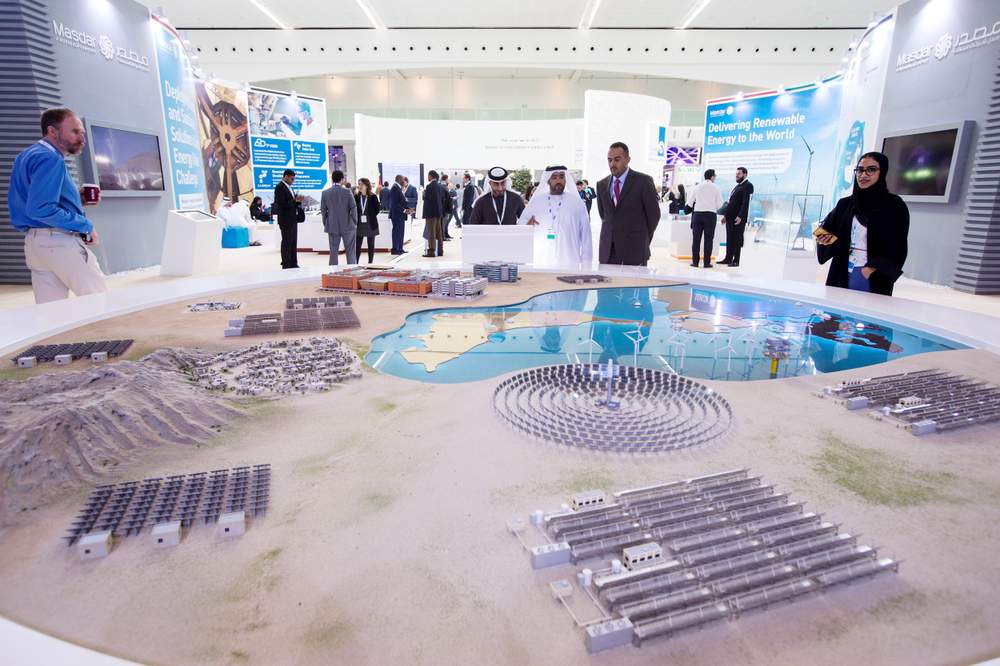“All transportation will be electric and self-driving. And that’s going to happen for purely economic reasons, not for sustainability.”
Faris Saeed took a big risk in buying his three electric cars. At the time he bought them there were no brands available here, so he travelled abroad for all of them – a Fisker in 2013, a Tesla S in 2015, and Tesla X last year – to the United States and Geneva. But there was a problem. In fact, there were several.
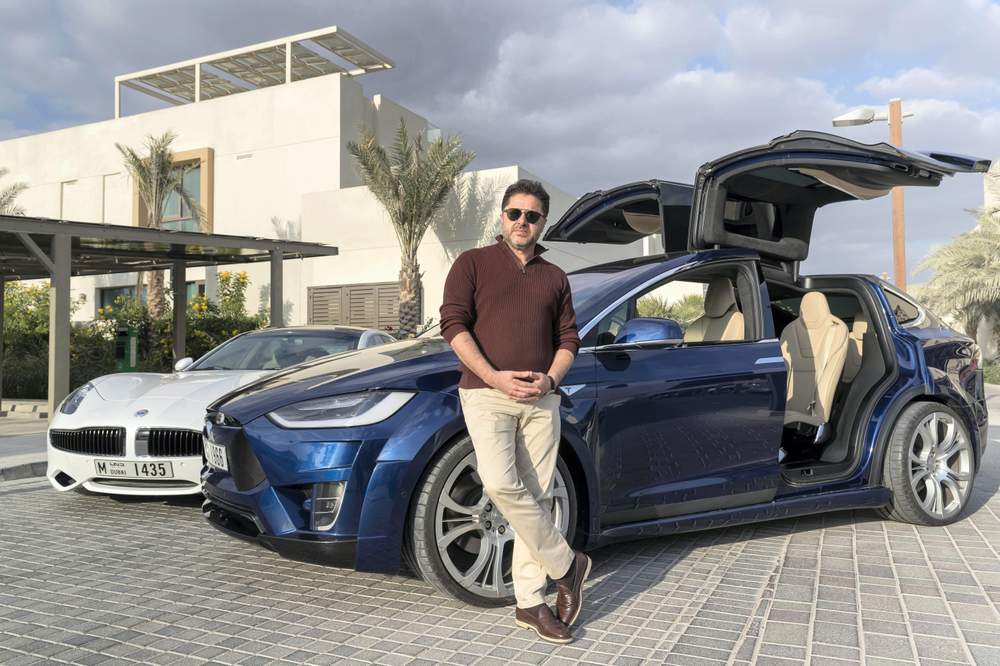
Faris Saeed, the developer behind Sustainable City,
with his Fisker and Telsa EVs.
Photo: Antonie Robertson/The National
He could not fully insure them here because he bought them abroad, and had to settle for third party insurance at the time. And, because there were no dealers here, he could not even maintain them.
“It was so difficult but I am in love with electric cars, so I took the risk,” says the chief executive of Diamond Developers, which built Sustainable City.
That all changed when Tesla launched in the UAE.
“The acceleration of the transition to electrical cars is now booming,” says Mr Saeed.
Both Dubai and Abu Dhabi are working to actively encourage the use of electric vehicles by installing charging points across the cities. Since 2014, Dubai has installed around 100, and the number will double by the end of the year.
“What the government is doing through DEWA by spreading these charging stations everywhere is helping. So the triangle of things, which are the concerns of people – all banks are doing finance, all the agents are doing maintenance and the third one is the charging,” says Mr Saeed.
“I don’t have any problem charging the car. There are charging stations everywhere. The logistics of these things make it much easier for people to move to electric cars.”
As of early last year, Abu Dhabi had 12 charging stations, but the number is also growing.
Experts say Tesla’s presence in the UAE is playing a significant role in the development of the electric vehicles market.
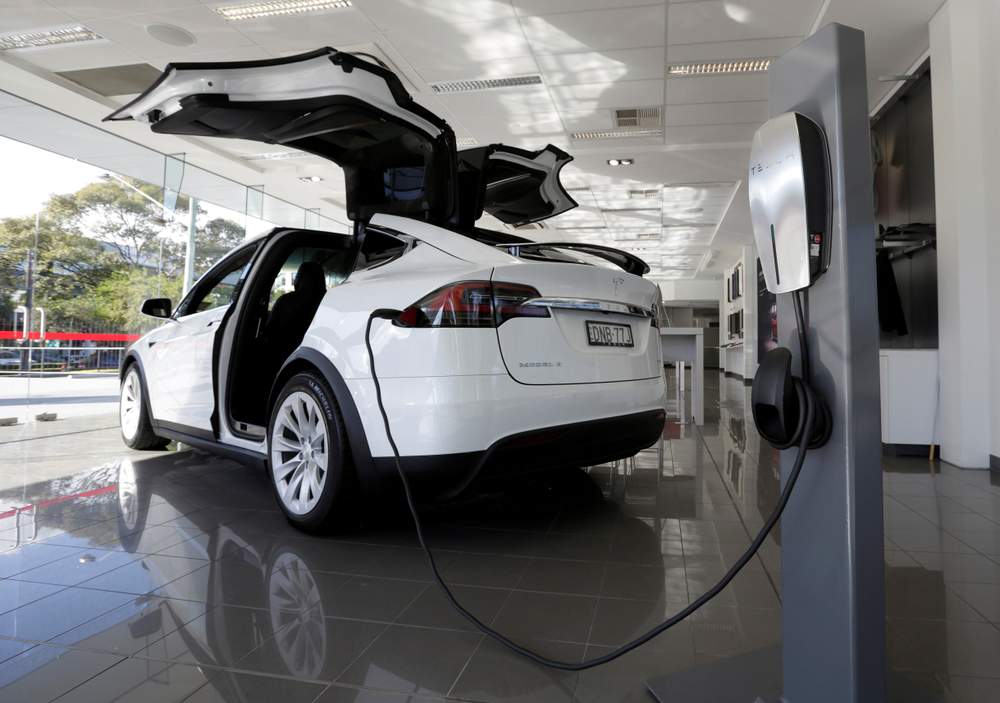
A wall connector is used to demonstrate how a Model X vehicle can be charged at home, at a Tesla electric car dealership in Sydney, Australia.
Photo: Jason Reed/Reuters
It is a trend setter in the same way Apple is in technology, says Ivano Iannelli, the chief executive of Dubai Carbon.
“Creating this buzz is key to maturing the market,” says Mr Iannelli, who drives a Fisker.
But another important aspect is now being introduced which will further spur the development of the market – the introduction of cheaper electric vehicle models.
Renault launched the Zoe 40 model here last year, and the Chevrolet Bolt will be available in the in the fourth quarter. This year will also see the launch of the Tesla 3 in the UAE.
“With Tesla 3 there will be a huge transition and a very fast one towards electric cars,” says Mr Iannelli.
And the reduction in price of electric vehicles is key in accelerating sales, say experts.
Economic choice
Tony Seba is a serial Silicon Valley entrepreneur and the author of several books, including Clean Disruption of Energy and Transportation, Solar Trillions and Winners Take All. In addition, he is an instructor in Entrepreneurship, Disruption and Clean Energy at Stanford’s Continuing Studies Program. Mr Seba will be speaking in Abu Dhabi during the World Future Energy Summit this month.
He claims that by 2030 potentially all energy will be solar, purely because of the reduction of the price in the related technologies.
“All transportation will be electric and self-driving. And that’s going to happen for purely economic reasons, not for sustainability," he says.
At the time of the book’s publication in 2014, he claimed that will happen because of exponential improvements in technologies like solar and batteries – progress experts say is already evident.
“The power density of batteries has doubled over the last few years,” says Mr Iannelli.
“Take my car as an example. My car has a very small battery and a very small range, a roughly 20KW battery, which gives me an electric range of 80 to 100KM range percharge. Now the same vehicle is fitted with batteries which provide three times the same range, [but with] the same space, the same cost.”
In 2014 when Mr Seba published Clean Disruption of Energy and Transportation, he said that by the end of 2017, the market would have several cars that would have a range of 200 miles at a cost of $35,000 to $40,000.
Just now there are two, and next year there will be several more. So if you keep that cost curve going it is "pretty clear what’s going to happen," says Mr Seba.
“The median new car in America is about $33,000. By about 2020, a new electric vehicle will be cheaper by about 20 per cent than the median new car in America. Cheaper to buy and also it’s about 10 times cheaper to fuel and about 10 times cheaper to maintain. And also it lasts two and a half times longer,” says Mr Seba. “So essentially the rational economic choice will be for buyers to go electric.”
The date palm has played a key role in sustaining populations in the Arabian Gulf over the past 5,000 years – but it now represents a significant drain on the region’s dwindling water supplies.
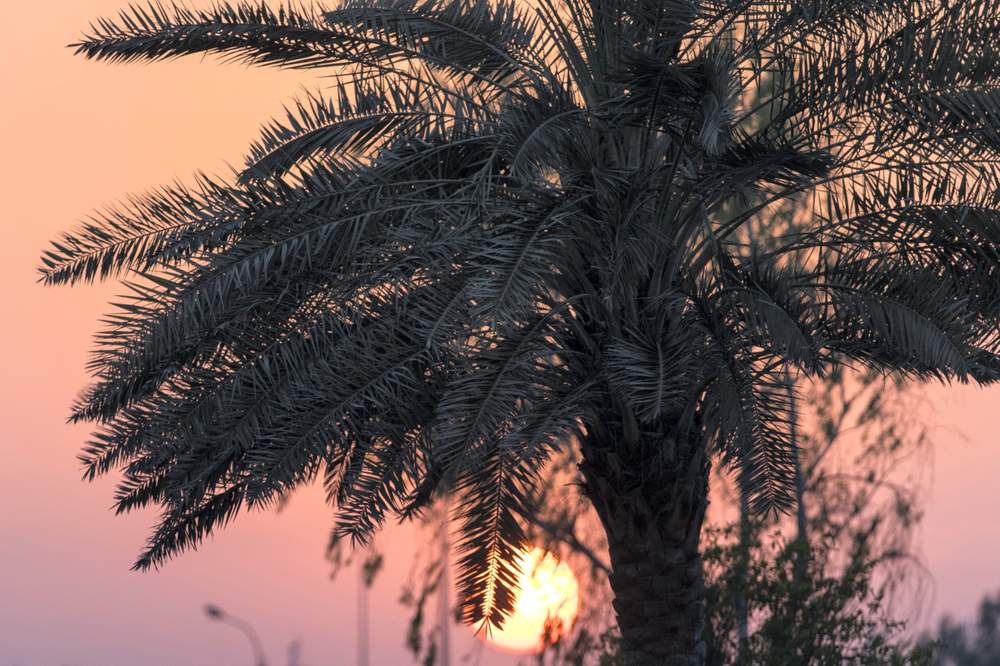
The sun sets behind a palm tree along the Corniche across from
Mina Zayed in Abu Dhabi.
Photo: Christopher Pike / The National
However, scientists based in the UAE have made significant advances in recent years in reducing the amount of water required in the irrigation of palms. It is estimated that date palm trees in the UAE consume more than one third of the total amount of water used in irrigation – which accounts for 275 litres per day per tree in the height of the summer.
“The UAE has a big problem with water consumption in terms of agriculture,” says Katherine Bruce, a sustainability consultant with AESG, who conducted a study on the use of the UAE’s water supply while studying for a Master’s Degree in Sustainable Development at Cambridge.
“The UAE uses a lot of groundwater still for agriculture, for the date palms. So it is rapidly depleting its groundwater supply,” adds Ms Bruce, who last year won a European Space Agency competition which challenged people to come up with ideas to use satellite technology to improve sustainability. She joined AESG in September and is currently working on a government project that is looking at water reduction in buildings and homes.
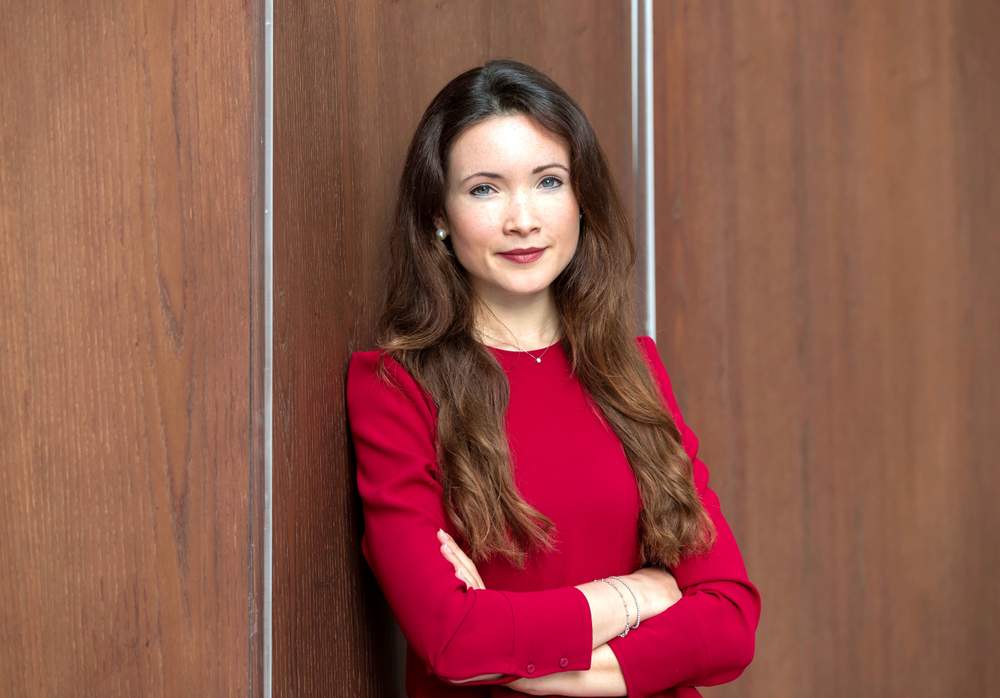
Katherine Bruce of AESG explored how the UAE uses its water supply while studying at Cambridge.
Photo: Chris Whiteoak / The National
According to statistics released by the Environment Agency Abu Dhabi in 2013, ground water made up the vast majority – or 94 per cent – of what was used for agriculture in the emirate. And studies conducted by the EAD in previous years have shown that ground water levels have been falling by up to five metres each year in the most agriculturally intensive areas. This is of particular concern because the UAE is one of the world’s most water-scarce nations – the country came third in a global ranking in 2013 for per capita water consumption with an average consumption rate of 550 litres of water per day per person. The number is more than three times the world’s average. Most of the water the UAE uses is desalinated as the groundwater supply is so low. The UAE is estimated to have around just 4,052,000 million cubic litres of groundwater, which is rarely replenished by rainfall. And estimates suggest that the country’s groundwater supply could completely depleted by 2030.
“Abu Dhabi, and the UAE in general, faces a significant challenge of water scarcity that threatens water security, native species of plants and animals, plus agriculture and forestry,” says Dr Abdullah J Al-Dakheel, a senior scientist with the the International Center for Biosaline Agriculture (ICBA). “One of the key strategies for addressing groundwater sustainability includes conservation and regulating for the responsible use of available groundwater.”
In 2014, scientists in the UAE from the International Center for Biosaline Agriculture (ICBA) and the Abu Dhabi Environment Agency (EAD) formed a technical partnership with the Plant and Food Research (PFR) institute in New Zealand, sought to do exactly that, by launching a project which aimed to reduce date palm irrigation requirements.
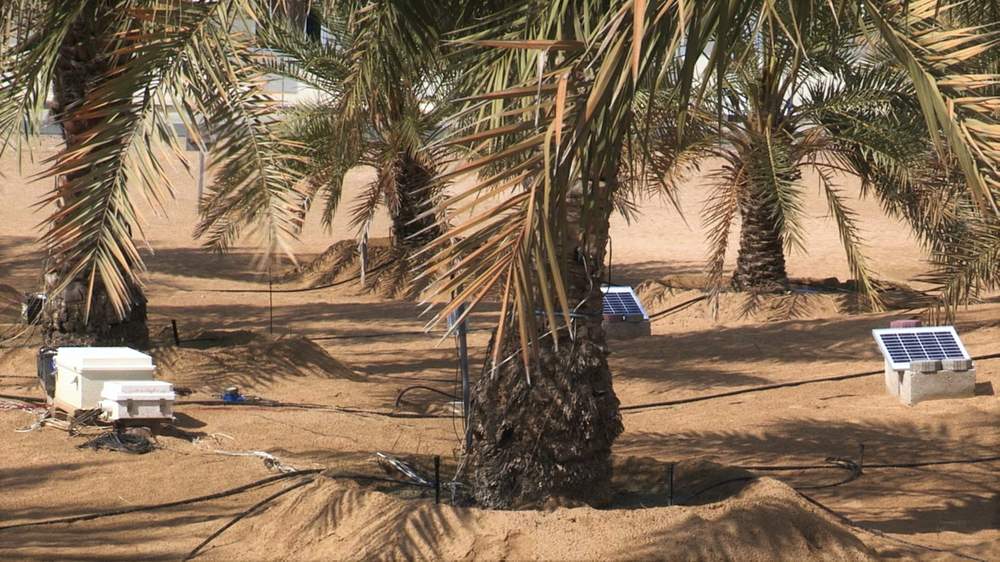
Date palm trees at the experimental field at the ICBA. Solar panels are used to generate power needed for the sensors that record the trees' water requirements.
Photo: courtesy ICBA
The project began by measuring the amount of water required by one date palm variety; Lulu, which was later expanded to two more, Khalas and Shahla, using sensors, as it was not known how much water they actually needed.
“Measuring the actual water use by the date palm tree is not an easy task, therefore the project uses advanced technique of measuring the actual amount of water passes through the plant trunk up to the branches and leaves,” says Dr Al-Dakheel.
Their results confirmed that trees were being over watered by a factor of two and a half times– and showed that more than 50 per cent of water was being lost in drainage beyond the root area. The team concluded that savings could be made in water of 35 per cent, when compared to current practices. ICBA has gone on to showcase the work internationally, most recently in Egypt, where it shared the results of its long-term study at the 3rd Date Palm Festival in the Siwa Oasis in November of last year.
“EAD is leading the effort in regulating the water use in AbuDhabi, the outcome of this project that was supported by EAD and ICBA will leadto the implementation of policy guidelines for the use of water in date palmirrigation,” says Dr Al-Dakheel. “Certainly, the implication of the finding of this research will benefit farmers in the UAE and the region in general and ultimately help in better management of water resources and date palm agro-ecosystem sustainability,” he adds.
It is not just innovation in water conservation that is taxing bright minds in the sustainability space. At the CLIX marketplace at this year’s World Future Energy Summit, which is taking place as part of Abu Dhabi Sustainability Week running from January 13, US-based Agrint is one of the finalists in the competition for mentoring and funding in the innovation in agriculture space. Agrint has developed an early pest detection sensor for trees, providing real-time alerts on infestation. It is hoped the device can help with the 4 billion palm trees threatened by the deadly Red Palm Weevil.
Energy efficiency has become a critical and potentially lucrative sector as the economic benefits of improving existing buildings or developing more sustainable new homes become more well known among investors in the region.
As a result the number of companies and organisations working in this space has also grown along with the opportunities.
Dubai Carbon, established by the emirate's Supreme Council of Energy and the United Nations, is helping to lead efforts in the UAE to reduce energy used in buildings. It works with government and non-governmental companies and monitors CO2 emissions in the city.
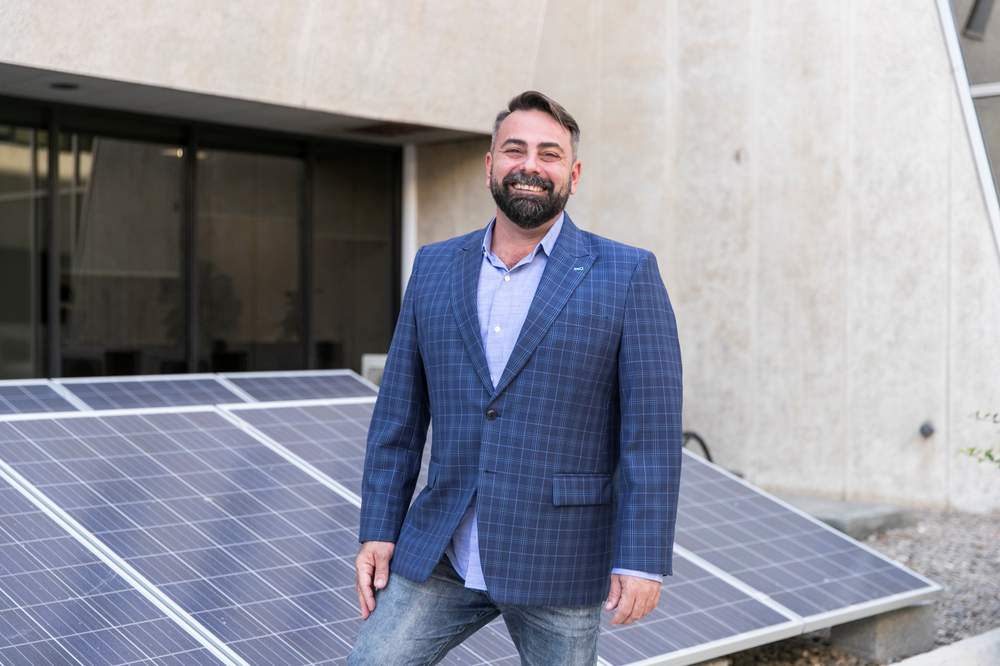
Ivano Iannelli, the chief executive of Dubai Carbon.
Photo: Reem Mohammed/The National
“The amount of CO2 emissions have been gradually decreasing over the past decade. They have actually more than halved in the last 10 years,” says Ivano Iannelli, the chief executive of Dubai Carbon.
He says the initial motivation is often economic, but once they are able to prove the extent of potential savings, the scale of the projects often ramp-up rapidly.
“When we start the programme, it is usually kicked off by the corporate DNA of the organisation, but once the numbers are proved by the efficiency of the programme, this is scaled 10-fold or 20-fold,” adds Mr Iannelli.
Innovative business model
Taka Solutions’ customers receive millions in energy savings – but do not part with a single dirham in capital in order to receive them. Instead, the energy consultant pays for all the work it carries out, and still makes a profit. And it has ambitions of rolling its successful business model out to the rest of the world.
The company was formed in the UAE almost five years ago, by a group of friends who spotted an opportunity in saving a large amount of energy, water, carbon and money by upgrading existing buildings.
“Most of us had been working on designing more buildings that we didn’t need, and we realised that our collective experience could be applied to a better use that would have a better impact on the world through reducing the impact of all the existing buildings,” says Charles Blaschke, the founder and chief executive of Taka Solutions, which is taking part in the CLIX competition during the World Future Energy Summit and Abu Dhabi Sustainability Week this month.
The company transforms old, inefficient buildings by upgrading them with smart energy technologies, saving anywhere between 20 per cent to 50 per cent of the building’s energy costs and reducing its carbon footprint. The average project saving is around 31 per cent.
“I guess the kicker, where it gets exciting, if that wasn’t exciting enough, is we don’t actually charge the customer. We pay for everything,” says Mr Blaschke, who will be speaking at the World Future Energy Summit.
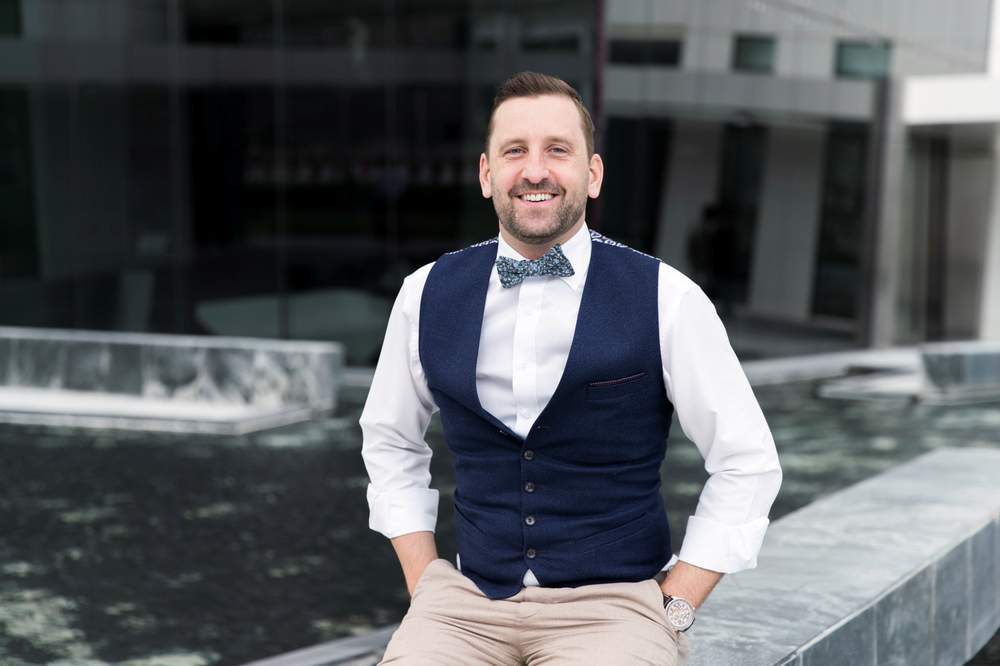
Charles Blaschke, the founder and chief executive of Taka Solutions, a UAE company with global ambitions which helps reduce the carbon footprint of existing buildings.
Photo: Reem Mohammed/The National
Taka Solutions covers the cost of the consultants, engineers and any contractors,and buys all the equipment, including any hardware and software.
“We pay everyone to put it in, and then we are there to monitor, operate and maintain everything that we have done in the entire building for a number of years,” says Mr Blaschke.
“Through that contract life we bill them a fraction of the savings, so anywhere between 50 per cent and 70 per cent,” he adds.
For example, if a building was previously costing Dh10 million in energy bills, Taka Solutions would carry out a series of upgrades – which could include replacing all the lights, the installation of new motors, pumps, fans, and new AC, which would collectively cut the building’s energy consumption by 30 per cent.
“What we would then do is we would say, okay, for the next five years, we will split that Dh3m. You get all this equipment and engineering,” says Mr Blaschke.
“Then give us the other 50 per cent to pay for the money we just spent on your building, so after five years we have gotten the money back that we put in the building and made a little bit of money.”
It also has another model, which allows a company to pay for the work itself. Taka Solutions then guarantees the Dh3m saving.
“If [the saving doesn’t transpire], we pay the difference. They are locked in with their payback and we are there to support, monitor, operate and maintain through the life of that contract. Then we also do a lot of consulting as well.”
The company has completed around 40 projects so far and is exploring around 300 more. It is funded by a local family office and has a target of about Dh500m to invest in the UAE in the next four years.
“We think we will probably be closer to Dh1 billion if we do our job and we have that set up ready to go. And nobody else in the market is anywhere close to that,” says Mr Blaschke.
Sharjah is starting to take off, and Abu Dhabi is doing well just now too, he says. By next year, the company expects to be working in Saudi Arabia, and it also has plans to enter the US, South America, and Thailand.
“I think the logical step is we will deliver some of those projects over time, but I think it will go Abu Dhabi, full UAE, GCC and Saudi and then Europe and the US,” he says.
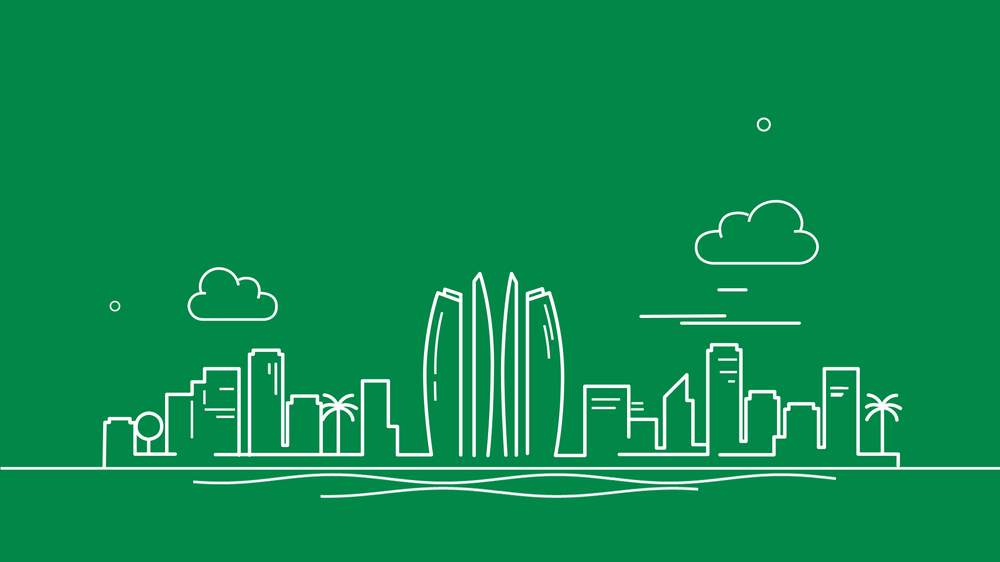
Sustainable vision
At the height of the financial crisis, Faris Saeed and his partner in Diamond Developers, Wassim Adlouni, returned to the drawing board. Having succeeded in the boom and weathered out the storm, delivering on the projects they had sold, they were sure Dubai would bounce back. And they wanted to do something different when it did. So they began visiting sustainable projects around the world, in cities like Denmark, Japan,California, Germany and England.
“They had a small team, because they couldn’t sustain a larger team during the crisis. So there were literally four or five of them,” says Karim El-Jisr, ExecutiveDirector of See Nexus Institute, which is part of the Diamon Developers group.
“Eventually they decided ‘let’s build a sustainable city,' and when they looked at land post crisis, they eventually looked at Dubailand, because it is an area of Dubai which the vision is to build communities and cities with a theme, just like Motor City and Global Village.”
They called it Sustainable City, in the same vein. The land for the project, which aims to be Dubai's first net zero energy city, was acquired in 2013, and construction started in January 2014. See Nexus Institute is the brains behind the city’s technology solutions. Phase one of the project is now complete, comprising 500 villas, which are divided into five clusters of 100 villas each. There is also a mixed use development of 89 apartments with some retail and office space, as well as a mosque, kindergarten and a farm, with bio domes which grow leafy greens and vegetables in the winter.
“Eventually they decided ‘let’s build a sustainable city'”
“It also includes the equestrian centre,” says Mr El-Jisr. “And we also have all the infrastructure and the ring road, a bicycle track and a horse track and all the trees which bring a lot of ecological benefits. That was completed in 2016.”
The houses are designed to minimise energy consumption through passive design, which tries to reduce the effect of the sun. Inside, the villas include LED lighting, efficient insulation, energy efficient appliances and air conditioning and UV reflective paint to help deflect the heat of the sun.
“All of that brings down the energy footprint by at least 40 per cent compared to any other equivalent villa in Dubai,” says Mr El-Jisr. “The other half is that we then produce electricity. All of the villas have solar modules on the roof tops. Those modules bring down the remaining electricity bill by another 50 per cent.”
The development also promotes electric vehicles, with five charge points provided by DEWA and two by Tesla. Currently, 4 per cent of residents – or 11 families – have electric vehicles. But it aims to increase this to 25 per cent by 2020.
“It is achievable because we educate [residents on the benefits of owning one]. We do seminars for residents on sustainability etc and we also have seminars on electric vehicles to demystify it. And then we organize test drives. We invited Tesla here twice,” says Mr El-Jisr.
Phase two of the project, on which construction has just started, includes a school which promotes sustainability; a 143 hotel operated by InterContinental Hotels Group; a pediatric medical village, mainly offering care for children with special needs; and an institute to provide professional training in all fields of sustainability. The hotel will include sustainability features, encompassing everything from the food that guests eat, to the lighting, showers and furniture.
“And it has some targets as well. We would like 30 per cent of the food to come from the city. So that’s very ambitious. It will take some time to achieve it,” says Mr El-Jisr.
The pediatric medical village will provide alternative medicine which is non-intrusive and holistic and for in-patients, people who need longer stays or longer term treatment.
“So if they come with their families, they can stay in the hotel which is adjacent to it,” says Mr El-Jisr. “There is nothing like the Sustainable City, meaning we deploy everything under one roof – the farming, the solar, the electric vehicles, the water recycling, the landscaping we chose which is very drought tolerant. We didn’t invent anything but we kind of captured all of the best practices from around the world, tweaked them and then adapted them in one space.”
